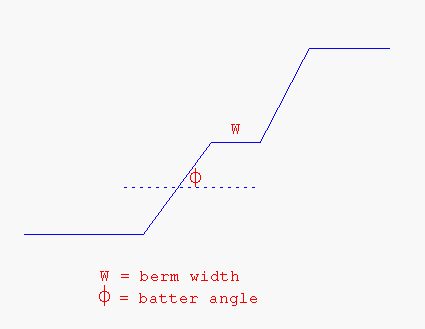Assign Berm/Batter values 
Assign a Batter Angle and Berm Width to a Pit or Dump Outline
This option is identical to the Ramps > Assign Berm/Batter values option.
The Assign Berm/Batter values option to apply batter angles and berm widths to a pit or dump outline before projecting it.
The batter angles and berm widths can be assigned manually to selected line segments in the pit outline, or they can be applied from variables in an indexed block model. The batter angle is the inclination from horizontal of the pit wall between berms, not the overall slope angle of the pit. Batter angles may be varied around the pit perimeter and from one lift to the next.

Figure 1: Batter Angle (Section View)
Berms, also known as catch benches, are narrow (typically 2-10m or 6 to 33 feet wide) flat benches that must be incorporated into the sloping walls of any pit exceeding a specified depth (generally every 10-20m or 33 to 66 feet of pit depth). The width of these berms may need to be varied around the pit perimeter due to different geological conditions or other factors. This can be done with the manual method of nominating different berms to different sections (line segments) of the pit perimeter.
Variable batter angles and berm widths are stored in the W tag of the points in a perimeter string. The values apply to the segments following the point. The W-tag holds both the assigned projection angles and the berm distances in a 9 character number. The leading numerals hold the batter angle for projection, and the trailing numerals hold the berming distance.
W-tag of 450000010 implies an assigned batter angle for a projection of 45 degrees and an assigned berming width for berming of 10 metres.
If only the batter angle is assigned, then the W-tag would read as 450000000. If only the berming width is assigned, then the W-tag would read as 10.
Unassigned faces will have point W-tags of zero. With the block model method, each point in the perimeter will inherit batter and berm values from variables held at each position in the block model.

